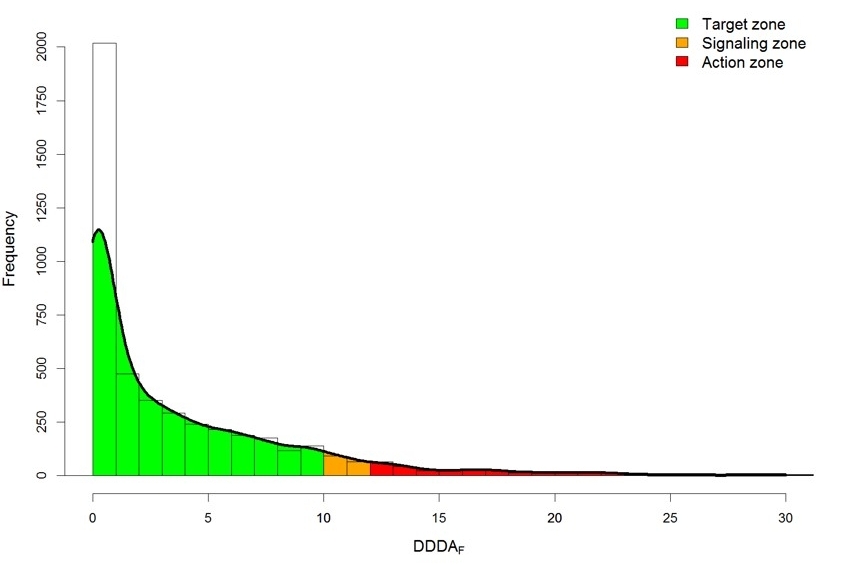Dutch sector quality systems and SDA
General
Several
quality assurance systems have sectoral databases in which sector-specific AMU
data is collected. The quality systems are run by the respective sector
organisations. The (SDa), financed partially by governmental sources and
private sources, receives the totality of the sectoral AMU. Each quality system
has its own analysis, benchmarking and communication system. However, they all
have to apply to the analysis and benchmarking criteria as established by the
SDa. SDa also receives the sales data from FIDIN, the branch organization for
veterinary pharmacy products. SDa reports on an annual basis on trends in sales
and usage data. The SDa performs analysis on the combined data of consumption
and animal numbers delivered to SDa by the sectors. All systems together cover
100% of AMU in the targeted sectors. In addition to this, SDa also monitors the
AMU in sheep, goats, mink, horses and pets by regular surveys.
Data collection
Animal subcategories: in pigs, by age categories: sows +
piglets, fatteners + gilts, weaners; in calves, by farm types: white veal, red
veal start-up, red veal fattening, red veal combi; in cattle, by gender and age
category: dairy cows, suckler cows, bulls for meat, rearing animals; in rabbits:
doe + kits, growing does, fattening rabbits.
Input: amount of antibiotics prescribed needs to be provided by the vets. The quality systems provide the average number of animals present over a period of a year, collected annually by inspection visits, or by using the compulsory ‘Identification & Registration System (I&R)’ for registration of animals.
Input: amount of antibiotics prescribed needs to be provided by the vets. The quality systems provide the average number of animals present over a period of a year, collected annually by inspection visits, or by using the compulsory ‘Identification & Registration System (I&R)’ for registration of animals.
Analysis
Data is analysed using
the nationally defined dose-based unit of measurement DDDA, established at
product level. From this UM, the indicator ‘animal daily doses per year’ is
calculated per animal category. The weights at treatment are estimated and
nationally defined. In broilers and turkey weight curves are applied since 2017
to estimate the weight at treatment. For all-in-all-out veal farms, a DDDA per
animal group is calculated next to animal daily doses per year. Growth curves
are applied to estimate weight at treatment for the DDDA per animal group
calculation, a standardized weight is used for the daily doses per year.
For vets, the DDDA per vet and the veterinary benchmark indicator (VBI) are calculated - see 'Benchmarking'.
For vets, the DDDA per vet and the veterinary benchmark indicator (VBI) are calculated - see 'Benchmarking'.
Benchmarking
Benchmarking for overall
AMU is done for farms as well as vets. The basis for the farm is the
#DDDA/year. This is presented to the farmers through the online interfaces of
the different systems. SDa itself does not provide benchmarking reports for
vets or farmers but instead outlines the national criteria based on the farm-level
results.
In general, the benchmarking is developed according to the principle that there are two threshold values (warning and action), that define three zones. The thresholds are defined by the SDa and depend on the animal and category. If a party finds itself in the action zone, the action that needs to be performed and the possible penalties depend on the sector.
Vets are benchmarked on a specific indicator calculated for that purpose: the Veterinary Benchmark Indicator (VBI). This is based on the DDDA/year of the farms they have a 1-1 relationship with divided by the action benchmark value for the particular type of farm, leading to the relative prescription ratio for each farm. Depending on the number of farms in the action zone and the degree of exceeding the action threshold, the VBI will increase. It reflects the likelihood the vet has a farm in the action zone.
The benchmark values for critical antimicrobials (fluoroquinolones and 3rd and 4th gen. cephalosporins are 0. These antimicrobials can only be used after sensitivity testing of infectious strains. SDa follows the proposed benchmark value for colistin as proposed by the European Medicine Agency (EMA). The benchmarking system will undergo several changes at the end of 2017, early 2018.
In general, the benchmarking is developed according to the principle that there are two threshold values (warning and action), that define three zones. The thresholds are defined by the SDa and depend on the animal and category. If a party finds itself in the action zone, the action that needs to be performed and the possible penalties depend on the sector.
Vets are benchmarked on a specific indicator calculated for that purpose: the Veterinary Benchmark Indicator (VBI). This is based on the DDDA/year of the farms they have a 1-1 relationship with divided by the action benchmark value for the particular type of farm, leading to the relative prescription ratio for each farm. Depending on the number of farms in the action zone and the degree of exceeding the action threshold, the VBI will increase. It reflects the likelihood the vet has a farm in the action zone.
The benchmark values for critical antimicrobials (fluoroquinolones and 3rd and 4th gen. cephalosporins are 0. These antimicrobials can only be used after sensitivity testing of infectious strains. SDa follows the proposed benchmark value for colistin as proposed by the European Medicine Agency (EMA). The benchmarking system will undergo several changes at the end of 2017, early 2018.
Reporting
SDa produces an annual report, published on the SDa website, with information
on:
- trends in AMU using sales data and sector-specific data:
- distribution of farms and vets over the different benchmark categories;
- use of critical antimicrobials.

More information
The Netherlands Veterinary Medicines Institute (SDa) website
